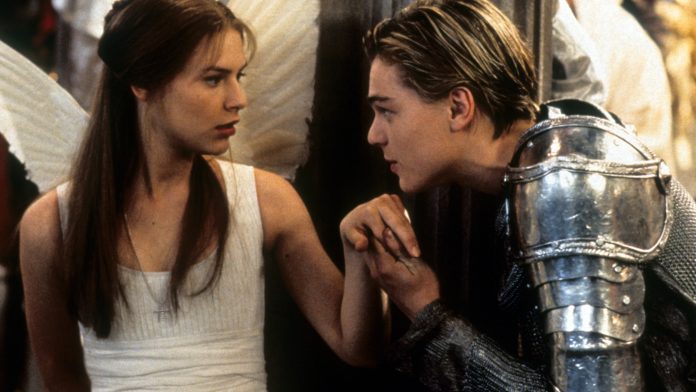The modernity infused upon Shakespeare accompanied by the brilliance of the original text makes this adaption of Romeo and Juliet the most memorable and rewatchable to date.
Romeo + Juliet remain one of Baz Luhrmann’s most iconic directorial endeavours. Despite his plentiful filmography of famed works, it is Romeo + Juliet has has become instilled in the public consciousness. Luhrmann even continues to appeal to fans with voiceover insights on his Instagram account. From the recent Video Music Awards (VMA) performance by Spacey Kasey—the staging and production of which was inspired by the film—to consistent Instagram edits dedicated to the film’s aesthetic and love story, it is evident Romeo + Juliet continues to leave a mark even 25 years later.
Romeo + Juliet is celebrating 25 years since its premiere in Los Angeles. As such, it seems right to commemorate the film by recognising what an innovative adaptation of Shakespeare it really is. innovation of this Shakespearean adaption, beginning with Mercutio (Harold Perrineau). On screen, Mercutio defies gender conventions. Set against a Mardi Gras-inspired costume party, Mercutio is introduced wearing stereotypically women’s clothing. Adorned in glitter and red lipstick whilst lip-syncing to Candi Staton’s ‘Young Hearts Run Free,’ Mercutio went beyond the source material and founded a new version of the character. Considered one of the most paradoxical characters in the tragedy, Luhrmann and Perrineau embrace this by making him undefinable. As a drag-queen adorned with a gun holster and a light-hearted presence during the first half of his performance, to later scenes showing him with a gaping shirt, a gun holster, and an aggressive demeanour, Mercutio meshes the masculine expectations of strength and anger with the feminine conventions of beauty, musicality and performance. Perrineau’s Mercutio feels like a fresh characterisation even now, managing to encapsulate the modernity of the film in his inclusive presence whilst embodying the juxtaposition of the glamour and the bloody conflict of Romeo and Juliet itself.
When remembering Romeo + Juliet, the scene which comes to mind is the couple’s first meeting in an aquarium, accompanied to the soundtrack of Des’ree’s ‘I’m Kissing You.’ A certain dreaminess is evoked from both parties attempting to isolate themselves, yet finding each other all the same (in a bathroom of all places). The innocence and wistfulness of the couple is captured in Leonardo DiCaprio’s and Clare Dane’s performances as Romeo and Juliet. It is reliant on longing looks, small gestures, and their subsequent severe actions. If love was a commodity, Luhrmann managed to capture it and sell it to audiences as something truly valuable. It is no stretch to say that DiCaprio secured his heartthrob status here, before cementing it a year later in Titanic. Lying testament to his longstanding career and Oscar nominations, DiCaprio encapsulates the rebellious, intensely emotional nature of Romeo, who is a fighter—or more accurately, a knight—for true love. Yet in gesture, he is very much a teen in the way he behaves impulsively, aggressively, and with vigour throughout the film.
Nothing says middle class like Juliet’s home; the winding staircases, guarded costume parties, and an aquarium recount just a few features of their wealth. And yet, Luhrmann dismantles the idea that Shakespeare is for only the highest class by bringing it to a film medium, taking the story away from the reserved space of the theatre. He is able to transform a text that is considered inaccessible and high brow into something appealling on every level. Luhrmann uses Hawaiian shirts, fancy-dress parties, and gang culture to codify Shakespeare’s language into a modern context. Taking inspiration from Sydney’s rave scene and Miami’s Mardi Gras, it is clear the modern influences and medium gives Shakespeare a new leash of life whilst bringing it down to earth. The film draws a bridge of understanding for all by using the art of scenery, tone, and gesture to root this tragedy in accessibility. The repeated, favoured use of close ups throughout leaves no doubt in your mind what you are looking at. Whether it be a facial expression or a gesture, you have absolute clarity. So although Luhrmann abides by the original text, he transforms the theatrical conventions into a cinematic context to open the story up to new audiences and experiences (like the reality TV opening introducing the cast).
Numerous others deserve recognition for their part in ensuring the film’s place in history. Paris (Paul Rudd) dressed as an astronaut at the costume party, Juliet’s barely-there fringe which seems to have inspired Daphne in Bridgerton, and finally, whoever brought a storm to set the day of Mercutio’s death scene—the dramatics were unmatched.
A contemporary adaption of the same play is performing currently at The Globe in London. Romeo and Juliet will continue to be transformed into modern contexts, yet this adaption will remain one always provoked at the thought of Romeo and Juliet. It’s modernity, vibrancy and truthful performance prove that any future adaptions have tough competition in igniting such a faithful fanbase.
Words by Annabel Smith
Support The Indiependent
We’re trying to raise £200 a month to help cover our operational costs. This includes our ‘Writer of the Month’ awards, where we recognise the amazing work produced by our contributor team. If you’ve enjoyed reading our site, we’d really appreciate it if you could donate to The Indiependent. Whether you can give £1 or £10, you’d be making a huge difference to our small team.
